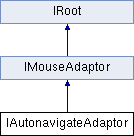Adaptor for autonavigating via mouse interaction. When the mouse button is pressed, the adaptor will autonaviate at the specified speed until the mouse button is released. Use ILibrary::CreateObject() to create this object.
Listens to: MousePressed(), MouseDragged(), MouseReleased()
| virtual signed int IAutonavigateAdaptor::GetNudgeable |
( |
signed int * |
pVal | ) |
|
|
pure virtual |
Gets the state of the autonavigation adaptor's nudgeable feature. As the camera moves along a vessel during autonavigation it may encounter branches in the vessel, making the direction of further of navigation ambiguous. If the Nudgeable value is set to H_TRUE the user can 'nudge' the autonavigation towards the desired direction by offsetting the mouse towards the channel the user desires to navigate into. If the Nudgable value is set to H_FALSE the autonavigation algorithm will determine on its own which direction to go.
- Parameters
-
| pVal | A pointer to a h_boolean value that will store the state of the nudgeable feature. |
| virtual signed int IAutonavigateAdaptor::GetSpeed |
( |
double * |
pVal | ) |
|
|
pure virtual |
Returns the current speed value into pVal.
| virtual signed int IAutonavigateAdaptor::SetNudgeable |
( |
const signed int |
val | ) |
|
|
pure virtual |
Sets whether the camera is 'nudgable'. As the camera moves along a vessel during autonavigation it may encounter branches in the vessel, making the direction of further of navigation ambiguous. If the Nudgeable value is set to H_TRUE the user can 'nudge' the autonavigation towards the desired direction by offsetting the mouse towards the channel the user desires to navigate into. If the Nudgable value is set to H_FALSE the autonavigation algorithm will determine on its own which direction to go.
- Parameters
-
| val | Set to either H_TRUE or H_FALSE to turn the nudgeable feature on or off. |
| virtual signed int IAutonavigateAdaptor::SetSpeed |
( |
const double |
val | ) |
|
|
pure virtual |
Sets the current speed value. The default is 1.0 and it is a simple multiplier coefficient for speed. However, it should be noted that the speed will automatically adjust based upon the size of the tunnel you are travelling down. For example, a small vessel will be autonavigated at a slower overall speed than the large intestine.
- Parameters
-
| val | The speed of autonavigation (default = 1.0) |

 Public Member Functions inherited from IMouseAdaptor
Public Member Functions inherited from IMouseAdaptor Public Member Functions inherited from IRoot
Public Member Functions inherited from IRoot 1.8.7
1.8.7